Pablo Picasso, a titan of modern art, redefined the boundaries of artistic creation with his revolutionary paintings. His career, marked by constant and daring evolution, has left an indelible mark on the art world. This article highlights ten of Pablo Picasso's most famous paintings, exploring the innovation and emotional depth that characterise them. From "Les Demoiselles d'Avignon", which paved the way for the paintings of Cubism, to "Guernica", a poignant symbol against war, each painting depicts a unique aspect of his artistic vision. Let's dive into Picasso's fascinating world together to discover how his masterpieces continue to inspire and challenge our perception of art.
Picasso's artistic beginnings
Pablo Picasso's first steps in the world of art bear witness to a prodigious precocity and a remarkable stylistic evolution. Born in 1881 in Málaga, Spain, Picasso showed an exceptional talent for drawing from an early age, encouraged by his father, himself a painter and art teacher. His family moved to Barcelona in 1895, where he attended the prestigious École des Beaux-Arts. There, he immersed himself in the city's artistic effervescence, experimenting with different styles and techniques. Picasso's blue period, characterised by cool tones and melancholy themes, began in 1901, influenced by the suicide of his friend Carlos Casagemas. This period was quickly followed by the pink period, marked by warmer tones and happier subjects, such as circuses and acrobats. These early phases of his career laid the foundations of his unique style and foreshadowed the revolutionary innovations that would establish him as a central figure in modern art.
The Ten Unmissable Masterpieces by Pablo Picasso
Pablo Picasso, the undisputed master of modern art, left a legacy of masterpieces that continues to captivate the world. Here is a selection of Picasso's ten most famous paintings, each reflecting a unique aspect of his creative genius and artistic evolution.
- 1. Les demoiselles d'Avignon
- 2. Guernica
- 3. La vie
- 4. Garçon à la pipe
- 5. Les trois danseuses
- 6. Le rêve
- 7. Dora Maar au chat
- 8. La lecture
- 9. La Femme qui pleure
- 10. La danse
1. Les Demoiselles d'Avignon
"Les Demoiselles d'Avignon", peint en 1907, est une œuvre révolutionnaire de Pablo Picasso qui marque un tournant décisif dans l'histoire de l'art moderne. Ce tableau, considéré comme le précurseur du cubisme, rompt radicalement avec les conventions de la perspective et de la représentation. Représentant cinq figures féminines nues aux traits déformés et angulaires, l'œuvre affiche une audace stylistique remarquable. Les influences africaines et ibériques, perceptibles dans les masques et les visages des personnages, témoignent de la quête incessante de Picasso pour un nouveau langage artistique. Avec ses couleurs frappantes et sa composition disruptives, "Les Demoiselles d'Avignon" défie les perceptions traditionnelles de la beauté et de l'art, établissant Picasso comme un avant-gardiste visionnaire.
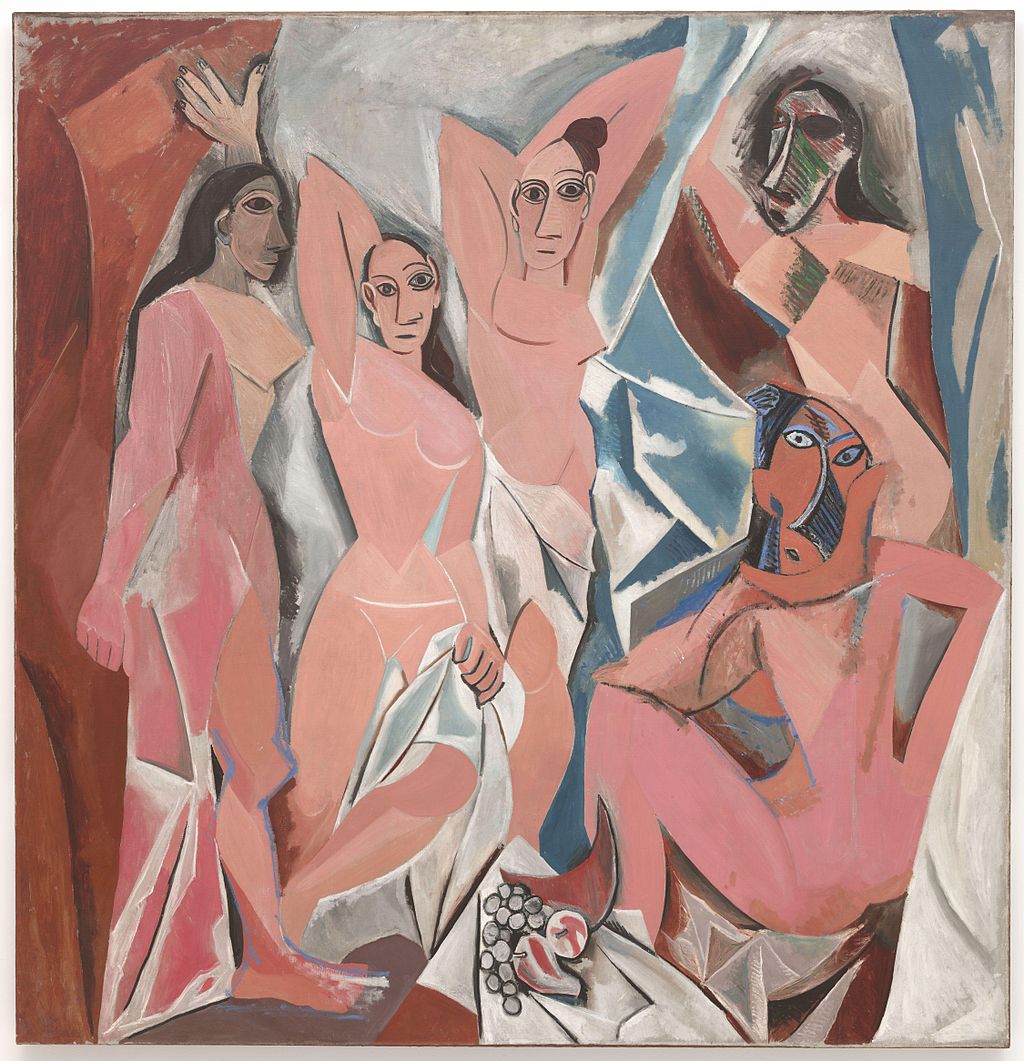
2. Guernica
"Guernica", created in 1937, is one of Pablo Picasso's most poignant and politically charged works. This immense canvas is a reaction to the destruction of the Basque town of Guernica by Nazi aerial bombardment during the Spanish Civil War. The painting, executed in shades of grey, black and white, depicts the terror and suffering inflicted on the civilians. The chaos of the scene is accentuated by fragmented, tortured figures - a horse in agony, a mother mourning her dead child, a broken warrior. The absence of colour amplifies the sense of desolation and horror. "Guernica" is not only an artistic statement against the brutality of war, but also an emblematic work that elevated Picasso to the status of a symbol of peace and resistance against oppression.
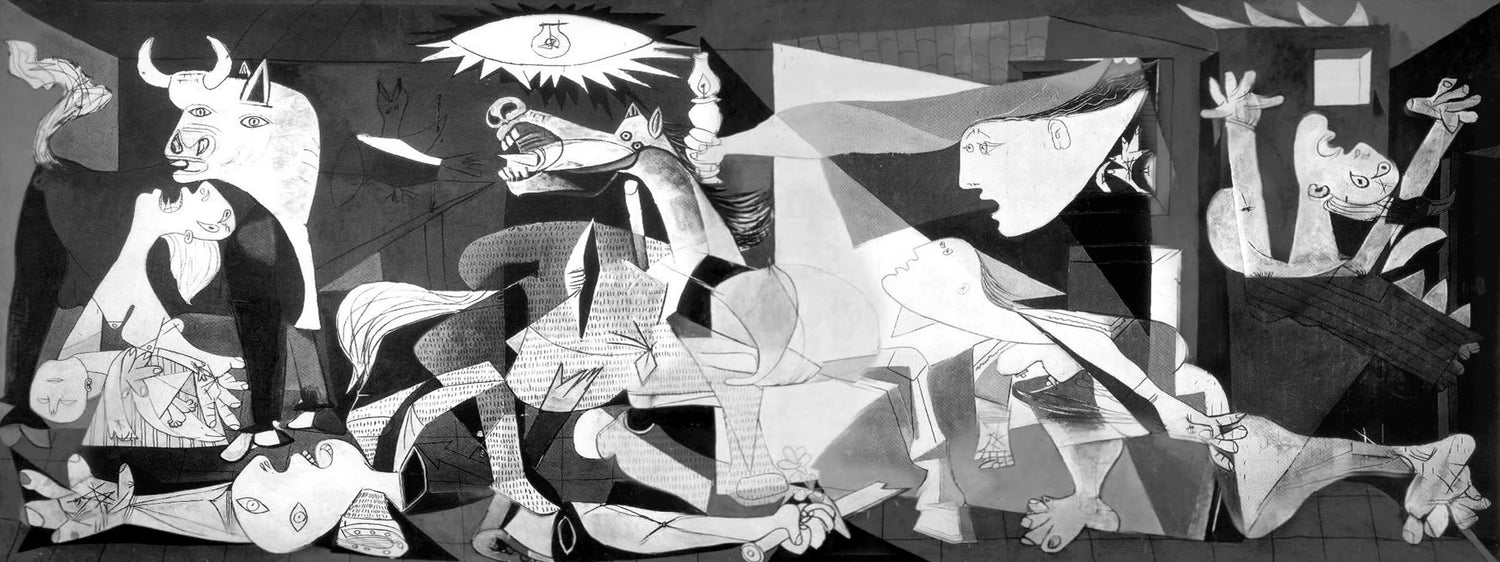
3. La vie
"La Vie" (Life), painted in 1903, is a key work from Pablo Picasso's blue period. This painting, imbued with deep melancholy and complex symbolism, illustrates the artist's early interest in the themes of human existence and mortality. The painting shows a naked couple with a child, surrounded by figures that seem to evoke questions of life, death and destiny. The dominant blue tones reinforce the sombre, contemplative tone of the work, while the composition and expressions of the figures invite reflection on the human condition. "La Vie is considered to be one of the most poignant expressions of Picasso's blue period, a period marked by poverty and personal grief, and it remains a key work for understanding the development of his art.

4. Garçon à la pipe
"Garçon à la pipe" (Boy with a Pipe), painted in 1905, is an emblematic work from Pablo Picasso's pink period. The painting depicts a young boy holding a pipe, with a crown of flowers on his head, symbolising the innocence and beauty of youth. The warm pink tones characteristic of this period contrast sharply with the melancholy of his earlier blue period. The boy's dreamy expression and the softness of the colours create an atmosphere of serenity and contemplation. This work is remarkable for its simplicity and elegance, demonstrating Picasso's ability to capture the essence of his subjects with an economy of detail. "Garçon à la pipe" remains one of the most charming and beloved examples of Picasso's pink period, perfectly illustrating his transition to a more lyrical and poetic style.
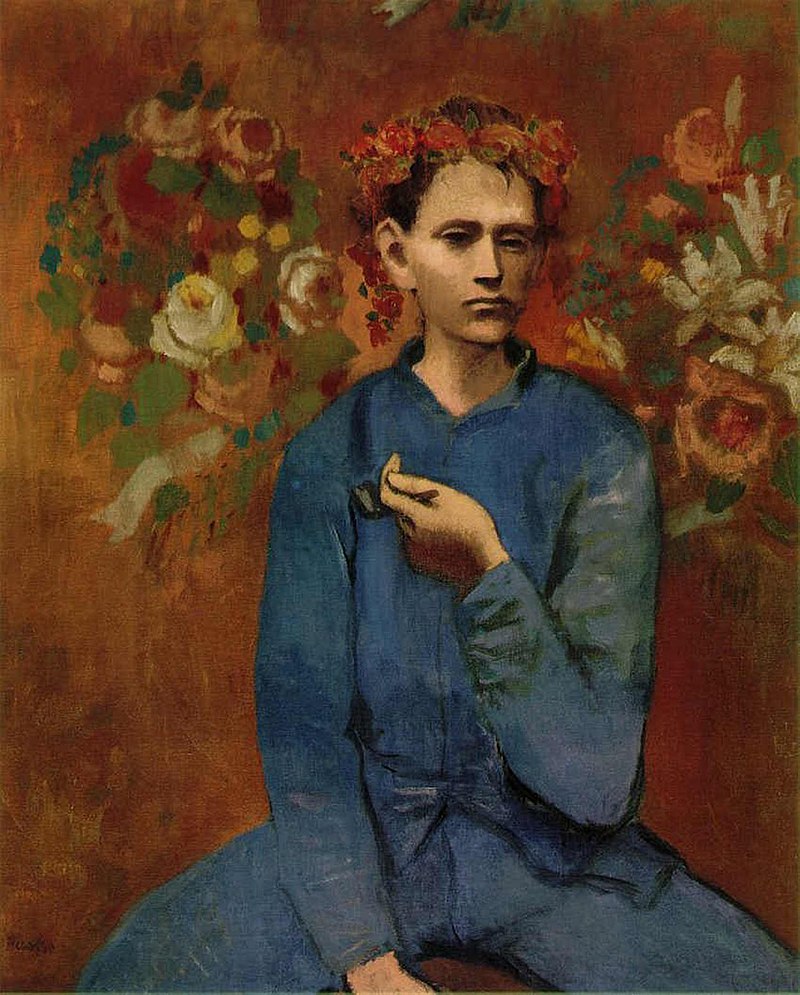
5. Les trois danseuses
"Les trois danseuses" (The Three Dancers), painted in 1925, is a major work by Pablo Picasso that belongs to his Surrealist period. The painting depicts three female figures in a dancing pose, but represented in an extremely abstract and distorted manner, typical of Picasso's Cubist style. The bright colours and angular shapes create an impression of intense movement and dynamism. This work is interpreted as a complex exploration of passion, desire and jealousy, recurring themes in Picasso's work. The arrangement of the figures and the bold use of colour and form break with traditional conventions, offering a more emotional and psychological view of reality. "The Three Dancers is considered a powerful illustration of Picasso's creative genius, fusing Cubism and Surrealism to express the depths of human experience.
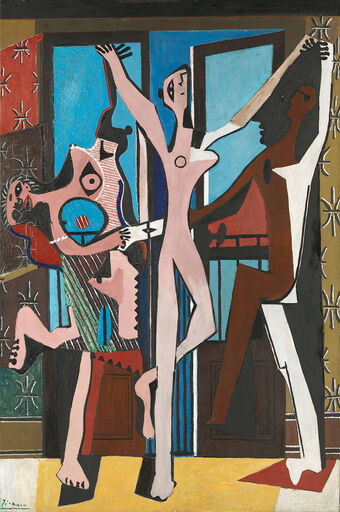
6. Le rêve
"Le Rêve" (The dream), painted in 1932, is one of Pablo Picasso's most famous and sensual works. This painting, depicting his muse and lover Marie-Thérèse Walter, is a masterpiece from the artist's Surrealist period. The figure's face, divided into two distinct parts, combines elements of peaceful sleep and erotic awakening. The bright colours and voluptuous forms create an atmosphere of dream and desire, capturing the spirit of Surrealism while remaining true to Picasso's unique style. "Le Rêve" is particularly notable for its bold, abstract depiction of female sexuality, a theme that often permeated Picasso's work. Both provocative and deeply personal, the painting offers a fascinating insight into the intimate relationship between the artist and his muse, and his ability to express complex emotions through his art.

7. Dora Maar au Chat
"Dora Maar au Chat", painted in 1941, is a striking and complex portrait by Pablo Picasso. It depicts Dora Maar, the artist's photographer and lover, sitting on a chair with a small cat on her shoulders. The portrait is characteristic of Picasso's Cubist style, with angular geometric shapes and a palette of bright, contrasting colours. The depiction of Dora Maar combines strength and fragility, her penetrating gaze and the slightly twisted posture of her body expressing both tension and emotional intensity. The cat, a surreal element, adds an extra dimension, perhaps symbolising duality or wild instinct. This painting is one of many portraits Picasso made of Dora Maar, each reflecting different facets of her complex personality. "Dora Maar au Chat" is considered to be one of Picasso's most powerful and psychologically profound works, demonstrating his mastery of Cubist portrait painting.
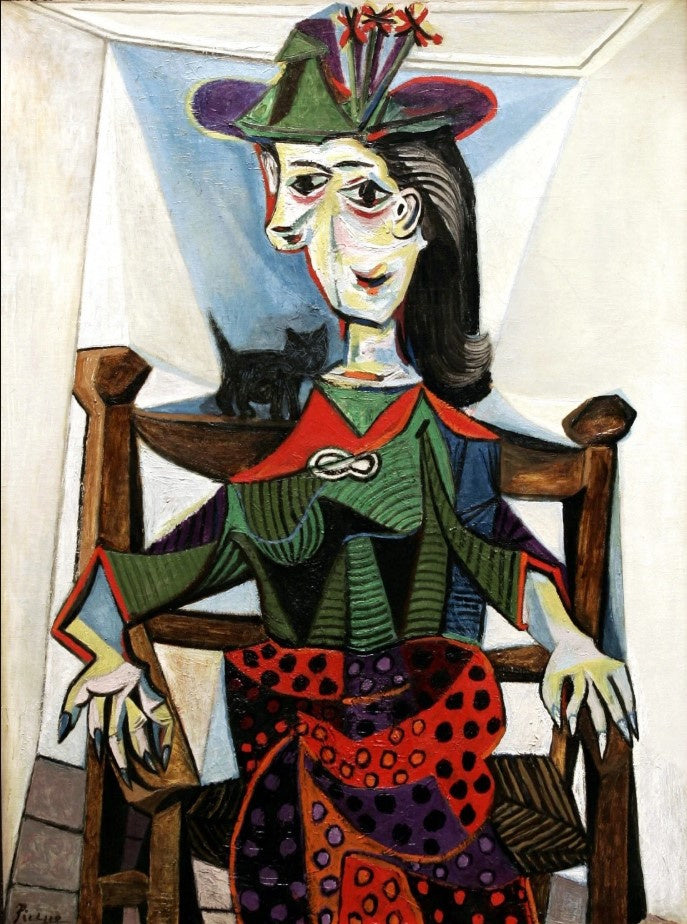
8. La lecture
"La Lecture", painted in 1932 by Pablo Picasso, is a captivating work that illustrates an intimate, everyday scene. The painting depicts his muse, Marie-Thérèse Walter, absorbed in reading a book. This portrait, painted during a period of happiness and tranquillity in Picasso's life, is distinguished by its warm, luminous colours, reflecting the serene, contemplative atmosphere of the moment. The simple yet expressive composition, with its use of soft, rounded forms, contrasts with Picasso's earlier blue and pink period, marked by darker, more melancholy themes. "Reading" is a remarkable example of Picasso's ability to capture the essence of a quiet moment, while infusing the work with an almost dreamlike quality. The painting is often interpreted as a tribute to youth, love and inner peace, recurring themes in works from this period of his life.
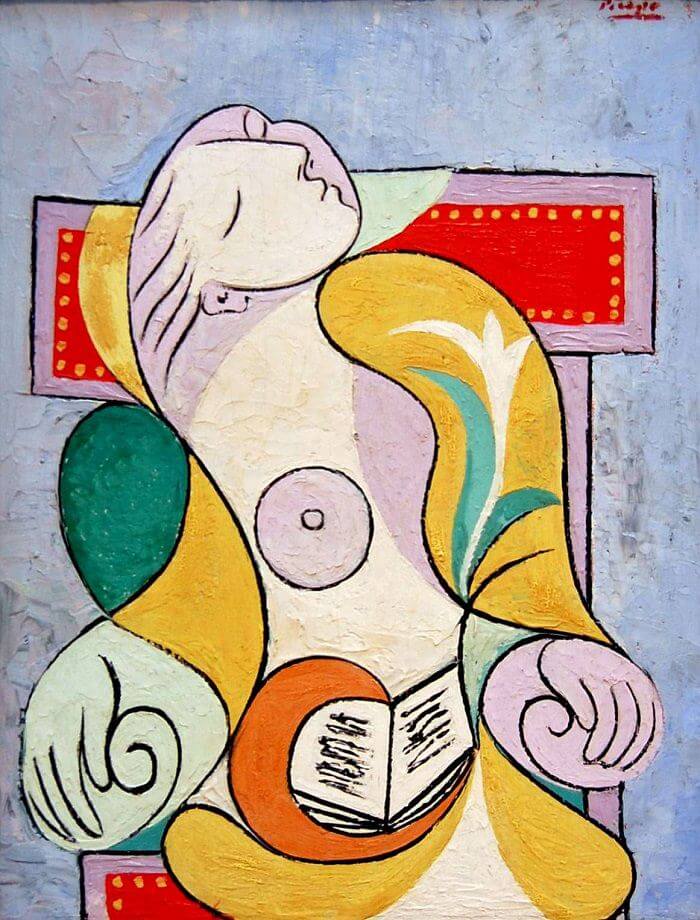
9. La Femme qui pleure
"La Femme qui pleure", created by Pablo Picasso in 1937, is an expressive and emotionally charged work that reflects the horrors of war. This painting was created in the same period as "Guernica", as a direct response to the tragedies of the Spanish Civil War. The painting depicts a woman in tears, her face distorted by pain and grief, symbolising the universal despair caused by violence and loss. The vivid colours and fractured forms accentuate the emotional intensity of the work, while Picasso's cubist style adds a dimension of fragmentation and chaos, evoking destruction and suffering. "La Femme qui pleure" is considered to be one of the most powerful representations of human pain in modern art, illustrating Picasso's ability to convey deep and complex emotions through his paintings.
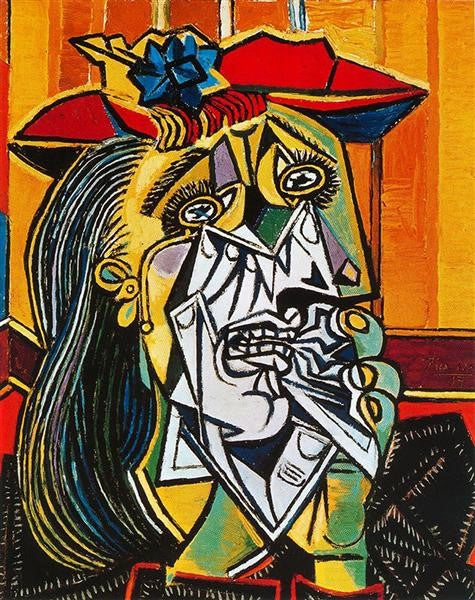
10. Selfportrait
The self-portrait painted by Pablo Picasso at the beginning of his blue period, in 1901, is an introspective and emotional work that marks a significant turning point in his artistic career. In this painting, Picasso depicts himself with melancholic, pensive features, enveloped in the shades of blue that characterise this period. His face, captured with incisive precision, reflects a deep introspection and a certain sadness, an echo of his personal struggles and his empathy for those on the margins of society. The cold colours and sombre mood of the work contrast with his earlier, more vivid and colourful work, marking the beginning of a creative phase in which loneliness, poverty and despair become central themes.
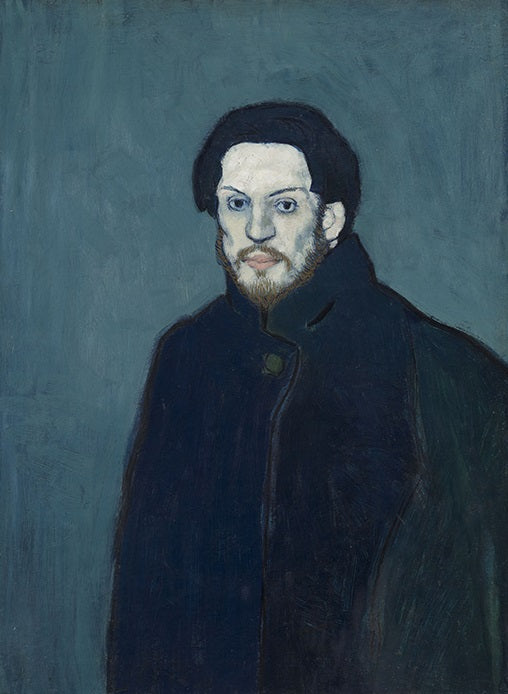
Concluding remarks
In conclusion, the exploration of ten emblematic paintings by Pablo Picasso plunges us into the world of an artist who redefined the boundaries of modern art. Each work, with its singularity, emotional depth and stylistic innovation, bears witness to the diversity and richness of his talent. From his beginnings in the Blue Period to his Surrealist experiments, Picasso not only captured the essence of his time but also opened the way to new artistic perspectives. His paintings remain cornerstones of art history, continuing to inspire and fascinate future generations with their power and originality. In this way, Picasso's legacy remains a priceless treasure, an eternal testament to his genius and avant-garde vision.



